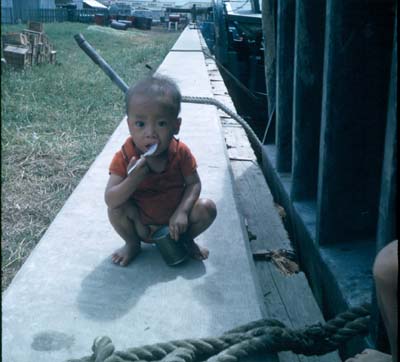

In August 1944, NCDUs from Utah Beach participated in the landings in southern France, the last amphibious operation in the European Theater of Operations. During Operation OVERLORD, not a single demolitioneer was lost to improper handling of explosives. Casualties at Utah Beach were significantly lighter with 6 killed and 11 wounded. They cleared 700 yards of beach in two hours, another 900 yards by the afternoon. Meanwhile, the NCDUs at Utah Beach met less intense enemy fire. The NCDUs suffered 31 killed and 60 wounded, a casualty rate of 52%. On 6 June 1944, in the face of great adversity, the NCDUs at Omaha Beach managed to blow eight complete gaps and two partial gaps in the German defenses. By April 1944, a total of 34 NCDUs were deployed to England in preparation for Operation OVERLORD, the amphibious landing at Normandy. On 6 June 1943, LCDR Kaufmann established Naval Combat Demolition Unit training at Ft. Kauffman, "The Father of Naval Combat Demolition," was directed to set up a school and train people to eliminate obstacles on an enemy-held beach prior to an invasion. Plans for a massive cross-channel invasion of Europe had begun and intelligence indicated that the Germans were placing extensive underwater obstacles on the beaches at Normandy. Rangers who captured the Port Lyautey airdrome. Their actions enabled the USS DALLAS (DD 199) to traverse the river and insert U.S. On 10 November 1942, this first combat demolition unit succeeded in cutting a cable and net barrier across the Wadi Sebou River during Operation TORCH in North Africa.
/arc-anglerfish-arc2-prod-mco.s3.amazonaws.com/public/WT2STT2KMRDPNNZMNB4RQHDVWM.jpg)
In September of 1942, 17 Navy salvage personnel arrived at ATB Little Creek, VA for a one-week concentrated course on demolitions, explosive cable cutting and commando raiding techniques. They conducted a survey of the Upper Yangtze River in the Spring of 1945 and, disguised as coolies, conducted a detailed three-month survey of the Chinese coast from Shanghai to Kitchioh Wan, near Hong Kong. They formed the core of what was envisioned as a "guerrilla amphibious organization of Americans and Chinese operating from coastal waters, lakes and rivers employing small steamers and sampans." While most Amphibious Roger forces remained at Camp Knox in Calcutta, three of the groups saw active service. King ordered that 120 officers and 900 men be trained for "Amphibious Roger" at the Scout and Ranger school at Ft. To help bolster the work of SACO, Admiral Ernest J. Scouts and Raiders were deployed to fight with the Sino-American Cooperation Organization, or SACO. The third Scout and Raiders organization operated in China. The 7th Amphibious Scouts conducted operations in the Pacific for the duration of the conflict, participating in more than 40 landings. The unit, renamed 7th Amphibious Scouts, received a new mission, to go ashore with the assault boats, buoy channels, erect markers for the incoming craft, handle casualties, take offshore soundings, blow up beach obstacles and maintain voice communications linking the troops ashore, incoming boats and nearby ships. Conflicts arose over operational matters, and all non-Navy personnel were reassigned. Later ops were at Gasmata, Arawe, Cape Gloucester, and the East and South coast of New Britain, all without any loss of personnel. The first mission, in September 1943, was at Finschafen on New Guinea. Scouts and Raiders also supported landings in Sicily, Salerno, Anzio, Normandy, and southern France.Ī second group of Scouts and Raiders, code-named Special Service Unit #1, was established on July 7, 1943, as a joint and combined operations force. Commissioned in October 1942, this group saw combat in November 1942 during OPERATION TORCH, the first allied landings in Europe, on the North African coast. Bucklew, the "Father of Naval Special Warfare," after whom the Naval Special Warfare Center building is named. The Scouts and Raiders mission was to identify and reconnoiter the objective beach, maintain a position on the designated beach prior to a landing and guide the assault waves to the landing beach. To meet the need for a beach reconnaissance force, selected Army and Navy personnel assembled at Amphibious Training Base, Little Creek, on 15 August 1942 to begin Amphibious Scouts and Raiders (Joint) training. While none of those early organizations have survived to present, their pioneering efforts in unconventional warfare are mirrored in the missions and professionalism of the present Naval Special Warfare warriors.

Today's Naval Special Warfare operators can trace their origins to the Scouts and Raiders, Naval Combat Demolition Units, Office of Strategic Services Operational Swimmers, Underwater Demolition Teams, and Motor Torpedo Boat Squadrons of World War II.


 0 kommentar(er)
0 kommentar(er)
